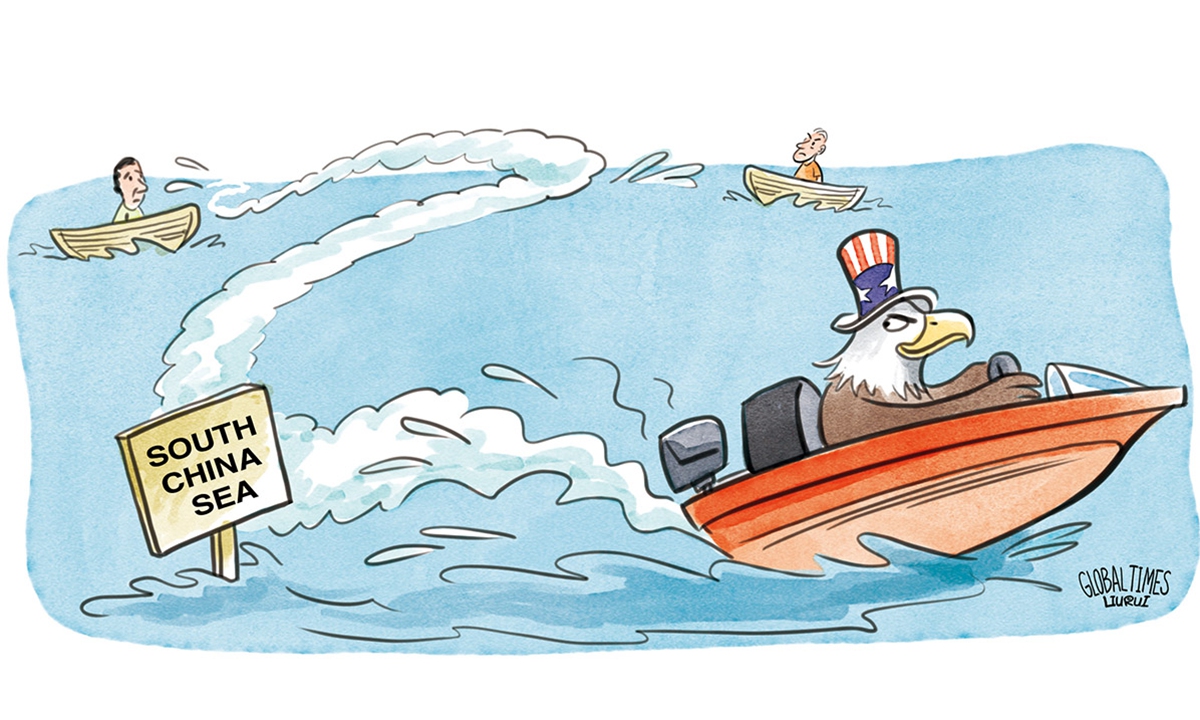
US prefers instability in the South China Sea. Illustration: Liu Rui/GT
As world dignitaries gathered in Singapore for debates on regional and global challenges at the Shangri-La Dialogue, Asia’s premier security forum, two of the world’s biggest military powers found themselves locked in a standoff.’
Pentagon officials slammed a Chinese warship of making an “unsafe and unprofessional” maneuver by cutting in front of the American destroyer sent halfway around the world to China’s Taiwan Straits. Portraying itself as a bulwark of “freedom of navigation” while brandishing its military prowess at others’ doorsteps, the US has been stirring up tensions in the Asia-Pacific for quite a long time.
It was no accident that the two defense chiefs only shared a handshake during the weekend overshadowed by the interception. What is suspicious is that the US’ incursion into the Taiwan Straits perfectly synchronized with the Shangri-La gathering against the backdrop of China’s refusal of mil-to-mil contacts between the Pentagon chief and Chinese defense minister, who is still under the US sanction.
Is it China’s fault not to accept a request from the US side to set up a meeting? Hardly so. How can you imagine an equal-footed dialogue between a sanctioner and a sanctionee? What is more, this absurd sanction itself is groundless. We can see no sincerity at all when someone asks others to talk with him while waving a club in hand as a threat. “Bullying” is the right word to define such behavior.
In fact, the US has long been enjoying a “freedom of bullying” in the region around China. The so-called “rules-based maritime order” is designed to advance its geopolitical agenda and heighten disputes. Furthermore, the US never cares or dares to explain what exactly the rules are – the rules that aim to maintain US dominance on the sea and in the air.
Examples abound of this country advancing its hegemony of navigation at the expense of other countries’ legitimate and lawful rights and interests. According to reports, in 2022 alone, US reconnaissance aircrafts conducted over 800 close-in flights to spy on China and US naval vessels were sent to areas of alleged “excessive maritime claims” to carry out military assertions. These actions have plunged the South China Sea and other waters into the maelstrom of conflict.
Is it true that someone’s lawful freedom of navigation was threatened in the waters surrounding China? “We have never heard of any of these ships having any trouble passing through or facing any security threats,” said Gen. Li Shangfu, Chinese State Councilor and Minister of National Defense, at the Shangri-La Dialogue. Instead of sowing discord and escalating tensions, China and Southeast Asian countries are committed to dovetailing their development strategies by accelerating cooperation in all sectors. Rather than being a source of global “concern,” the South China Sea should be built into a sea of peace, friendship and cooperation that brings tangible benefits for people in the region.
It is the US that has chosen to gang up with its allies to bolster its military presence in the Asia-Pacific region and bring tensions and disturbances to the region around China. From the “Pivot to Asia-Pacific” Strategy to the AUKUS submarine deal and the Quad alliance, mounting evidence makes it crystal clear that the US aims, through its “freedom of bullying” approach, to build blocs to counter China’s development.
Time will tell whether the US’ painstaking efforts will end in vain. But history may have already provided the answer: For centuries, the waters around China have remained peaceful and serene. Those ambitious schemers from outside the region have to face their failures of interference or dominance finally. In the vast ocean of peace, any standoff is nothing but a ripple.
The author is a commentator on international affairs, writing regularly for Xinhua News, CGTN, Global Times, China Daily etc. He can be reached at xinping604@gmail.com.




